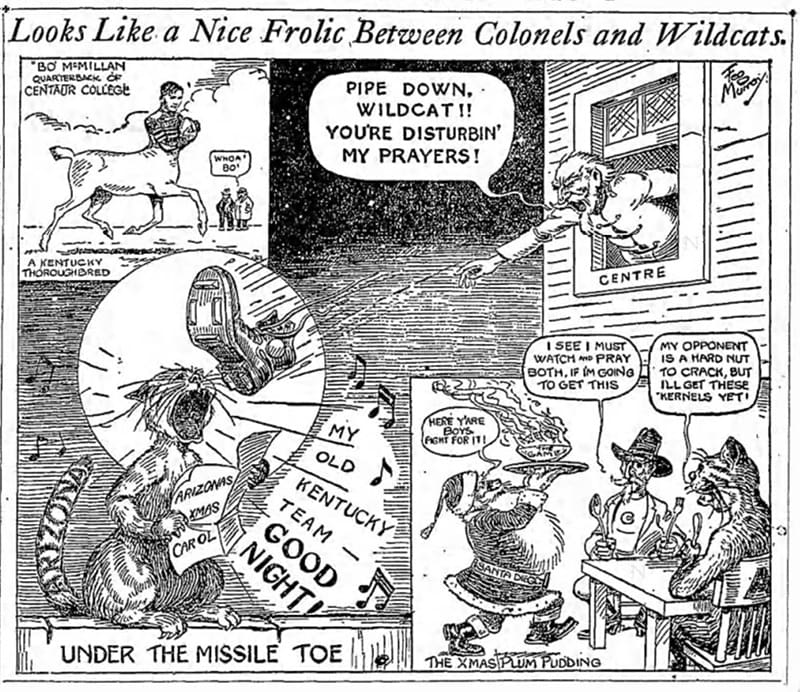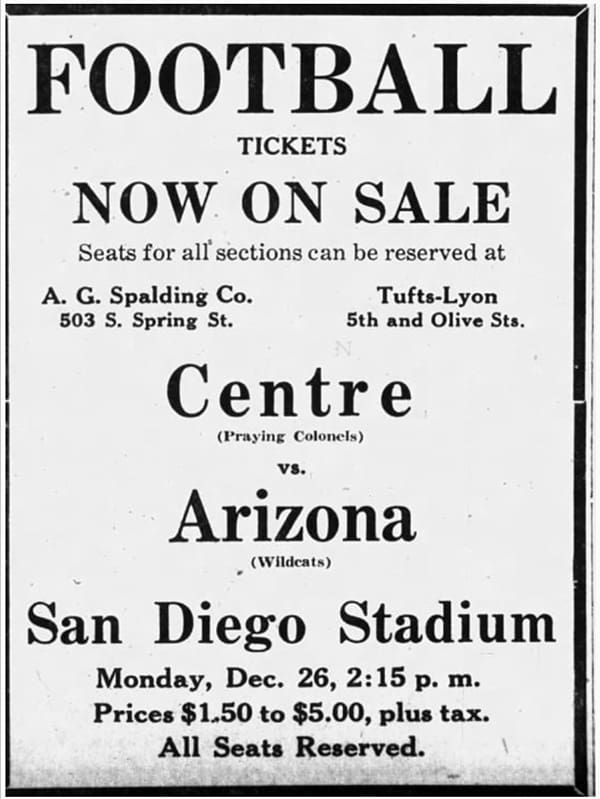"Quite Unusual Weather, Yes”
Historically, San Diego received little precipitation in December, at least normally. The citizens were more concerned about keeping the reservoirs full than about flooding.
YEAR DECEMBER RAIN/INCHES
1910 .15
1911 1.39
1912 .03
1913 .72
1914 2.21
1915 2.60
1916 1.14
1917 0 ( This is not a typo. )
1918 0 ( Nor is this. )
1919 .48
1920 .54
Since 1910, the total rainfall in eleven Decembers had only been 9.26 inches, for an average of .84 inches monthly.
Statistically, it looked like a pretty safe bet to schedule an outside event in December in San Diego.
There had been an unusual amount of precipitation during the first two weeks of the month. A light rain had then begun on December 18, five days before the Colonels arrived in San Diego. All of the West Coast had intermittent showers, and the team worked out on a wet field in Palo Alto, and an even wetter field in Los Angeles.
The Polo Field at the Coronado had been blessed with such thick tuft, periodically irrigated during the year, that the moisture on the grass wasn't really a factor.
Things began to look more mucky when the Colonels practiced on the wet, sandy soil which was considered a playing field, at Balboa Stadium.
Now, the situation was beginning to get serious. As the players looked out of the seaside windows of their rooms, the ocean could be heard, but certainly not seen. There was a full-blown storm, locked in right over Southern California, and what was going to happen tomorrow, game day, really couldn't be imagined.
Ticket sales to the game had been robust. There were 115,000 people in San Diego County in 1921, and there was an enormous interest locally, but what promised to swell the crowd to full capacity was the number of people who were planning to come down from as far away as San Francisco, and even more were planning to attend from the Los Angeles area. Many planned on purchasing their tickets when they arrived in the city.
There were several factors that had generated such enthusiasm for the game throughout the state. First, the fact that Centre had beaten Harvard made the "Wonder Team" known nationally.
Secondly, there had been many articles written prior to the final Rose Bowl pairing about the possibility of Centre playing the University of California in Pasadena. When that match-up didn't materialize, many football fans decided the next best thing would be to spend the day after Christmas in San Diego watching Centre play there.
The third reason was the coverage that the team was given in the San Francisco and Los Angeles papers when the Colonels spent a day in each city. The Centre players just made good press, and the public was hungry for any information about the college and its wonderful group of football players.

Coverage in the Los Angeles "Sunday Times" on December 25, the morning before the game.
Additionally, the organizing committee had placed ads in the Los Angeles papers about the game.

Ad promoting the game in Los Angeles newspaper, "The Record"
Both the Southern Pacific and the Atchison, Topeka and Santa Fe, better known as just the Santa Fe, ran regular passenger trains from Los Angeles to San Diego. Thousands of fans planned to come down to San Diego on the December 26 early morning runs south, so many that both railroads had additional coaches added to their consists to accommodate the numbers.
The last passenger train able to travel from Los Angeles to San Diego arrived at 6:35 P.M. on December 25. It carried a large number of fans who planned to stay overnight in the city and attend the game the next afternoon. No other rail traffic was possible after the arrival of that train, as the track between the two cities was covered with more than 2 feet of water in the Sorrento Valley north of San Diego. Further compromising travel was the tons of mud that obliterated the lines in the San Juan Capistrano area.
It had hardly rained in Tijuana while the Colonels were at the track, but it was a different story across the border. In the 24 hour period from 2:30 AM on the 25th until 2:30 AM on the 26th, 3 inches of rain had fallen, surpassing the old 24 hour record of 2.75 inches. It had been especially heavy since midnight and was still pouring when the team awakened on the morning of the scheduled game.
By game time, the total rainfall for December stood at over 9 inches, and when it finally finally stopped half way through the game, the accumulation was at 9.26 inches, exactly the total for the eleven previous Decembers, combined!
The storm wrecked havoc on the highways between Los Angeles and San Diego as well. On the coastal route, the bridge at Cardiff-by the Sea, south of Encinitas, was swept away. Further inland, Escondido was cut off from San Diego by damage to the bridge at Lakeside. And in the Imperial Valley, traffic was stopped at Dulzura, blocking passage into San Diego from the southwest.
The organizers of the Christmas Bowl were faced with a very tough decision. Should they go ahead? Postpone? Cancel?
The two coaches, Uncle Charlie and Arizona's "Pop" McKale, were consulted, and both said they would rather play on the scheduled date, but if necessary, could stay over another day and play on the 27th. However, there wasn't any guarantee that conditions would improve in 24 hours due to the vast amount of rain, and conditions may actually worsen.
The newspapers delivered on Christmas morning had run stories that the game was on, no matter what. This fact had a bearing on whatever decision the committee would make. But the major factor regarding playing or postponing, or even cancelling, was the matter of insurance.
Who would have thought that it would be necessary to insure against rain in December in San Diego? It seemed like money poorly spent. After all, December was typically dry. Seven of the last eleven years had a total December rain of less that an inch. Two years had no rain at all!
Who would have ever thought of taking out insurance?
The organizing committee was composed of good business men, men who wanted to put San Diego on the map by the publicity that a prestigious post-season game could generate. They had seen how Pasadena and the Los Angeles area had benefited by the Rose Bowl. They envisioned the same for their city. However, they were leery about guaranteeing money to the participating teams without some assurance that there would be funds available to pay out those guarantees.
Centre alone had been promised $16,000, equivalent to $250,000 in today's valuation of money. By the time Arizona was paid, and other expenses were covered, the committee felt it would need to take in $25,000 just to break even.
So, they went shopping and found an insurer who would pay out $25,000 if it rained at least one inch on the day of the game. The wording of the policy was critical. Rain "on the day of the game" meant just that. It was obvious that at least an inch would accumulate on the 26th because at midnight on the 25th, there had been no lessening but actually a strengthening of the intensity of the storm.
If the game were to be postponed and played the next day, on the 27th, and the rain had ceased, there would be no insurance payout, even if the crowd had been drastically reduced due to the weather having caused so many people to be unable to get to San Diego.
"We've got to play. We have no choice. The whole enterprise could be a big money loser. It would guarantee that we don't have a game next year."
The committee's vote was unanimous. The members were determined that the game would take place, as one participant later related, "come hell or high water."
"And we realized that may well describe the conditions."
